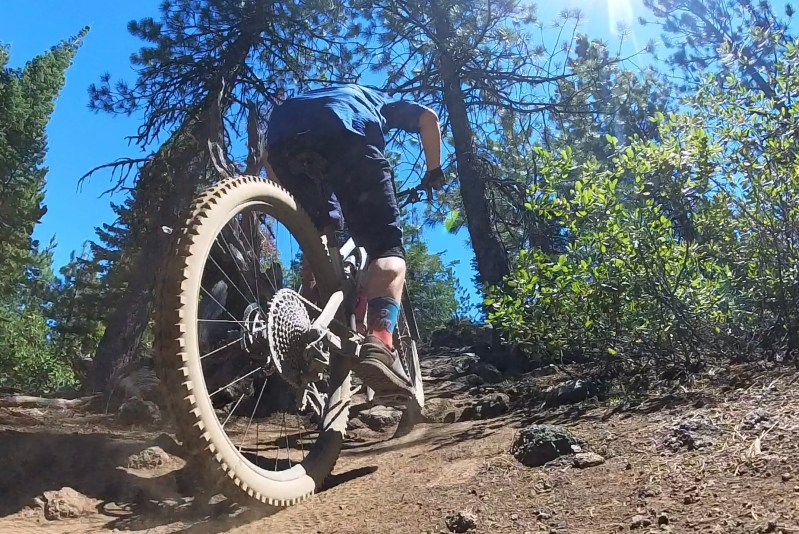
If you are new to mountain biking, it can all seem a bit overwhelming. So, new riders can tend to lean on outside sources to help them make decisions. One source commonly consulted is social media.
What mountain bike should I get? What trails should I ride? What mountain biking apparel do I need? You may find answers to these questions inadvertently on social media.
While these pros and influencers aren’t wrong, there are some things newer mountain bikers may want to consider.

Mountain biking trails that are too difficult too soon
If you are jumping into the world of mountain biking, you are likely starting to consume mountain bike content via social media. We have access to some of the best mountain bikers in the world through platforms like Instagram and YouTube, and viewing their content can certainly get you excited to go ride.
But, remember, their skill level far surpasses most. If you are new to mountain biking, stick to beginner and intermediate trails. Practice fundamental skills on those trails and get to the point where you are comfortable going fast on intermediate trails before stepping up to advanced trails.

A longer-travel mountain bike doesn’t equal better
When buying, deciding what type of mountain bike best suits you and the terrain you ride is one of the most critical decisions. Especially when you are new to mountain biking, it can be easy to think that bigger means better.
What is meant by this is that a mountain bike with more suspension will be a superior bike to one with shorter travel. To find out if it is, you need to think about a few factors:
- What style of mountain biking are you interested in?
- What are the trails like where you are going to ride?
Do you want to get into gravity mountain biking, with as much steep downhill as possible? Then longer travel will be a better option. Are the trails where you’ll be mountain biking 15-mile loops? A shorter-travel mountain bike will better suit you here.

Buying mountain biking gear and apparel too quickly
Mountain biking apparel isn’t necessary to ride your bike, but it is highly recommended and enhances the experience.
- Mountain bike-specific shoes provide better grip and support
- Mountain bike pants or shorts are well-ventilated and designed with riding in mind
- Mountain bike shirts wick moisture away from your body quickly
Once you start riding with apparel intended for mountain biking, you won’t go back to riding in regular clothes. The downside: mountain biking apparel is expensive.
Since mountain biking apparel can be expensive, don’t buy it all at once. Try different things to see what you like. You don’t want to drop a few hundred dollars on mountain biking jerseys only to find out you prefer Merino wool tops.
Acquire gear slowly. The reality is that while much of the mountain biking gear is good—it mainly comes down to personal preference.

Entry-level carbon mountain bikes
Most mountain bikes you may be interested in buying will have two options for frame material: aluminum or carbon fiber. For a while, carbon fiber seemed to be the superior material.
- Carbon is lighter than aluminum.
- Carbon is stiffer.
- Carbon absorbs trail chatter better.
But what this seemingly superior material also brought with it was a higher price tag. Carbon fiber frames are more difficult to make and are, therefore, more expensive.
To get customers on carbon frames, mountain bike companies often offer a carbon frame build option with lower-end components. However, the same mountain bike with an aluminum frame and higher-end components can cost the same.
Aluminum is also great.
- An aluminum frame may only be one pound heavier than carbon.
- While a carbon frame is stiffer, you may prefer the compliance of aluminum.
- Aluminum frames save you money so that trail chatter can be absorbed in a set of carbon wheels.
Pressure washers and mountain bikes don’t mix
Let’s say you have been out on an epic mountain biking adventure. Your bike and truck are covered in dirt and mud, so you swing into a self-car wash station. It can be tempting to blast your mountain bike with the pressure washer. Don’t do it.
Pressure washers may get a lot of dirt and grime off your mountain bike, but they also push that grime and water into your bearings and seals. Yes, you may have seen your favorite pro doing this exact thing on YouTube. Remember, your favorite pro has professional mechanics replacing all those bearings and seals.

Make the best decision for you
It is entirely normal to be influenced by outside sources when getting into mountain biking. Those sources can often be our friends who are already into mountain biking. Other times, we find ourselves making decisions based on what we see on social media.
Mountain biking social media isn’t bad; on the contrary, it can be beneficial. But it can tend to steer newer mountain bikers in a particular direction or, at the very least, overwhelm them with information.
When you watch these mountain biking pros and influencers, remember a few things:
- This is their job.
- Those bikes and all that gear were given to them.
Consider what they say, do, and recommend, but always do what is best for you.




